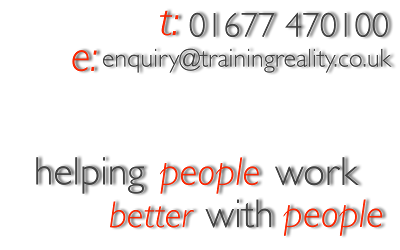Please press (at least!) one of these.
It costs you nothing, and (possibly) helps us spread the word!
Language and behaviour
Friday, 31 July 2009
Yet again, it’s a Radio 4 inspired blog today - one of those programmes that you catch a little bit of on a car journey, and then simply have to catch up with later. In this case, it was Word of Mouth on Tuesday afternoon - you can still just catch it at http://www.bbc.co.uk/programmes/b00ls65t.
The programme explored the relationship between language and some fundamentals of behaviour. Anyone familiar with NLP, sales training techniques, and myriad other management training tools will already be familiar with the effect that language can have (intentional and unintentional) on others. However, some of the aspects covered in this programme provided insight into much more profound differences that language can cause.
The two examples that really caught my ear (!) were as follows.
Firstly, many languages use absolute rather than relative spacial properties. In English, we generally use relative ones (to the left/right, or behind/in front of). However, in those languages with no words for left/right etc, people use absolute measure such as North West or South East. Therefore, to translate “the cup is on your left” would end up as something along the lines of “the cup is on your South West”.
The implications for this go way beyond the difficulties of translation. Research has shown that people who’s languages use absolute spacial properties have a cognitive ability that has been seen in birds and ants (for example), but not previously observed in humans - the ability to be perfectly oriented around points of the compass at all times. Language is actually affecting the development of mental and physical skill.
The second example takes what, in English, is a superficially simple statement, but, by looking at the potential pitfalls in translation, opens up a huge web of assumptions and limitations. The sentence was:
“My brother and his seven children live in the blue house to the left of the big tree”
Looking at this in terms of tricky translations:
My brother: some languages would require you to specify older/younger, or only have a word that means sibling, and doesn’t specify the gender.
Seven: some languages don’t have numbers, and therefore the translation would be a less-specific “many” or “several”.
Children: here, the gender is not specified, but in certain languages, you would need to make a distinction between male and female children.
Blue: in certain languages, you need to be more specific, defining a light blue or a dark blue, as there is no word for the generic blue.
Left: as covered above, if a language has absolute spacial properties, you would need to specify that the house was to the east-southeast of the tree.
Tree: and finally, in some languages, you would need to say “oak” or “beech”, as there is no generic word for tree.
For me, this is a fascinating, additional way of looking at the subtle impacts of the language we use, and the assumptions and missing information contained in even very simple phrases. This is covered thoroughly in the NLP metamodel by looking at deletions - unspecified verbs, comparative deletions, simple deletions and presuppositions. It also offers a great challenge to our regular assumption (even when two parties are speaking in the same native tongue) that the other party’s understanding of our statement is the same as ours.
Greater understanding of the assumptions behind the language we use can only be incredibly helpful!
Please press (at least!) one of these.
It costs you nothing, and (possibly) helps us spread the word!





